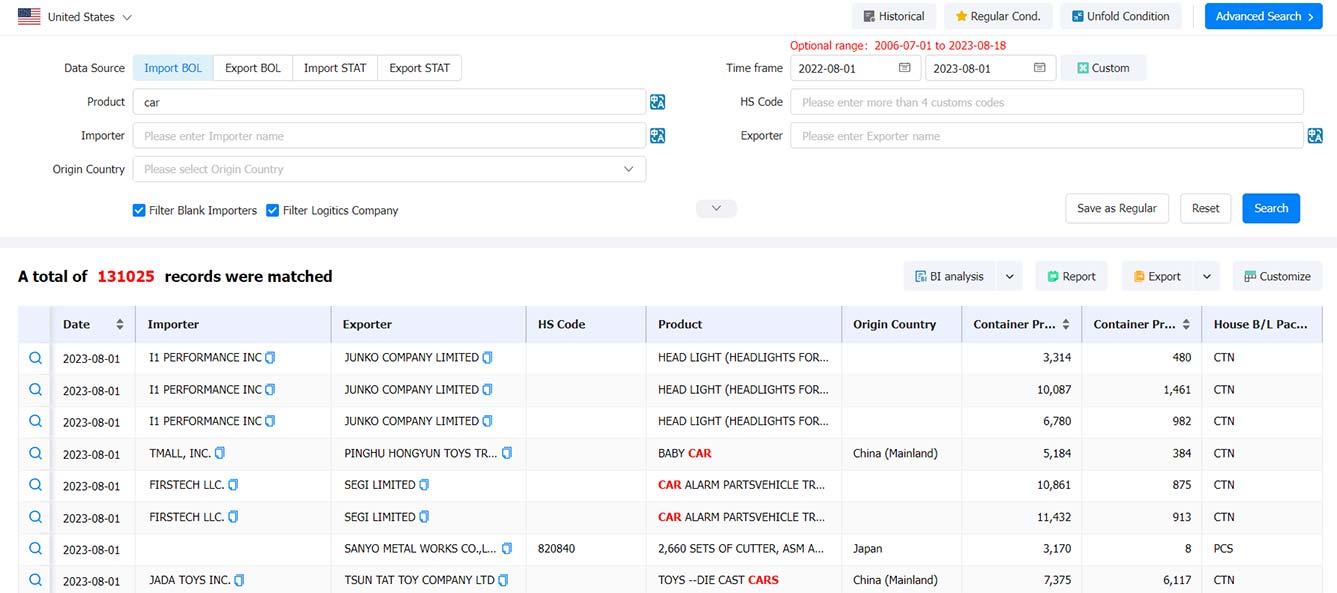 Trade Data
Trade Data
 24-09-2024
24-09-2024
U.S. import data serves as a crucial indicator of the nation's economic health, reflecting consumer demand, international trade relationships, and market dynamics. By analyzing this data, businesses, policymakers, and economists can gain valuable insights into market trends, identify opportunities, and mitigate risks associated with global trade.

In recent years, U.S. import data has shown significant fluctuations, influenced by various factors including tariffs, supply chain disruptions, and global economic conditions. For instance, many industries experienced substantial declines in imports due to factory shutdowns and shipping delays. However, as economies reopened, there was a marked increase in demand for imported goods, particularly in sectors like electronics, machinery, and consumer products.
Key Trends in U.S. Imports
One notable trend in U.S. import data is the shift towards greater diversification of sourcing countries. Traditionally, China has been the largest supplier of imports to the U.S., but recent years have seen efforts to reduce reliance on any single country. As a result, countries like Mexico, Vietnam, and India have emerged as significant trading partners. This diversification not only helps mitigate risks associated with geopolitical tensions but also supports resilience in supply chains.
Another critical aspect of U.S. import data is the ongoing impact of tariffs and trade agreements. Policies enacted during trade negotiations have altered the landscape, affecting which products are imported and from where. For example, the tariffs imposed on Chinese goods have prompted many companies to seek alternatives, thereby influencing import patterns significantly.
The Role of Data Analytics
To navigate these complexities, businesses increasingly rely on sophisticated data analytics tools. This is where platforms like Tendata come into play. Tendata provides comprehensive insights into import and export data, allowing businesses to analyze market trends, assess competitive landscapes, and make informed decisions. By leveraging Tendata’s powerful analytics, companies can enhance their market strategies, optimize their supply chains, and ultimately drive growth.
Impact of Consumer Demand
Consumer behavior also plays a pivotal role in shaping U.S. import data. As preferences evolve, the demand for certain products can rise or fall sharply. For example, the surge in demand for home improvement and electronic goods during the pandemic led to increased imports in those categories. Tracking these trends is essential for businesses aiming to align their offerings with market needs.
Future Outlook
Looking ahead, U.S. import data is expected to continue evolving. Factors such as sustainability, technological advancements, and changing consumer preferences will likely shape import trends. Companies that can effectively analyze and respond to these shifts will be better positioned in the competitive landscape.
Conclusion
In summary, U.S. import data offers a window into the complexities of international trade and consumer behavior. By understanding the trends and utilizing robust analytical tools like Tendata, businesses can navigate these waters more effectively. This not only aids in strategic planning but also enhances the ability to seize opportunities in a rapidly changing market.
For businesses seeking to deepen their insights into import trends and optimize their market strategies, Tendata is the ultimate solution to help you stay ahead of the curve.
1. Establishing a Customer Resource Repository by Country
Creating a customer resource repository is akin to your own work record sheet. Begin by utilizing trade tracking functionality to compile a list of all customers from a particular country. Next, perform specific analyses based on factors such as each purchaser's procurement volume, purchase cycle, product specifications, and supplier systems (with emphasis on examining the diversity or singularity of their supply channels; preferably retaining customers with diversified suppliers, as those relying on a single supply channel may be harder to develop). Lastly, filter out the potential high-quality customers constituting 30% of this country's total, and record them in your customer resource repository, allowing flexible categorization by country, time, customer name, follow-up steps, phone numbers, emails, and other contacts. (>>>Click to Start Developing Customers for Free<<<)

2. Creating a Customer Resource Repository by Peer Companies
Have a solid understanding of peer companies' English names (including full names, abbreviations, etc.). Utilize the global networking capability of suppliers to generate a list of all clients associated with peer companies within the system. Following this, perform essential analyses on these clients based on factors like procurement volume, procurement cycle, product models, and others. Ultimately, identify and record the key customers of your targeted peer companies in your customer resource repository. (>>>Click to Start Developing Customers for Free<<<)

3. Cataloging New Customers from Each Country
For newly emerging customers from specific countries, use the trade search function to select the country, set the date range and limit product names or customs codes. Check "Newest," and the search results will display high-quality customers that emerged most recently in that country within the designated timeframe. Since these customers are newly established, with recent procurement transactions, their supplier stability might be unsteady. Therefore, prioritize following up with these new potential buyers. Lastly, record all these new prospects in your customer resource repository. (>>>Click to Start Developing Customers for Free<<<)
All three strategies for utilizing customs data to develop customers can be tailored to your company's actual needs. Depending on market conditions, industry specifics, strategic requirements, etc., find the approach that suits you best, with the sole aim of classifying and organizing your premium customers. Once you've found suitable customers, the next step is to contact them precisely, employing various methods such as phone calls, emails, and online chats.
Category
Leave Message for Demo Request or Questions


 T-info
T-info T-discovery
T-discovery

 My
Tendata
My
Tendata Market Analysis
Market Analysis Customer
Development
Customer
Development Competitor
Monitoring
Competitor
Monitoring Customer Relationship
Customer Relationship




































































































































